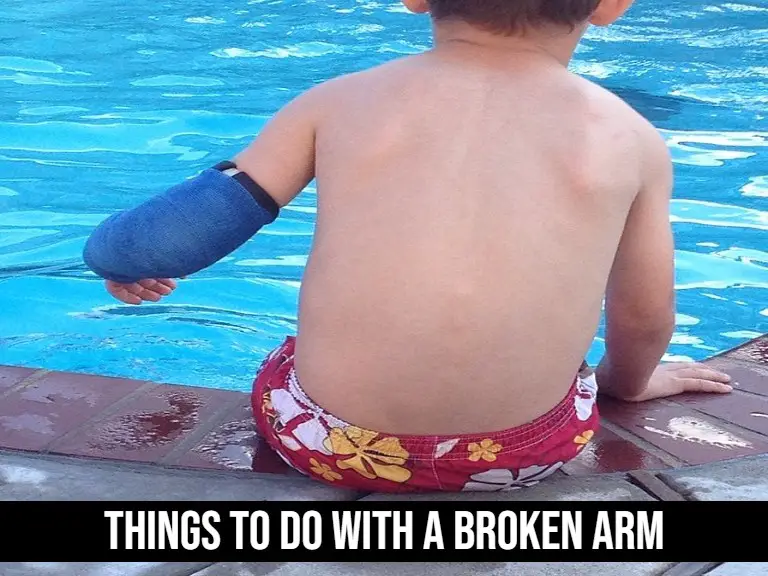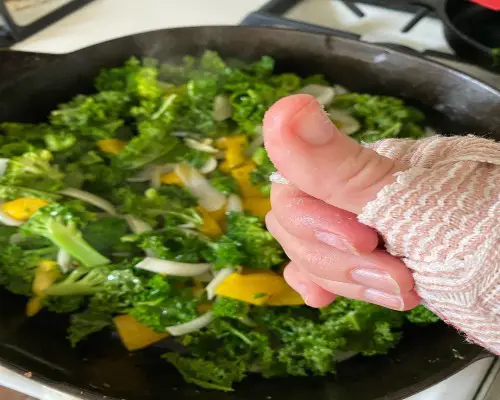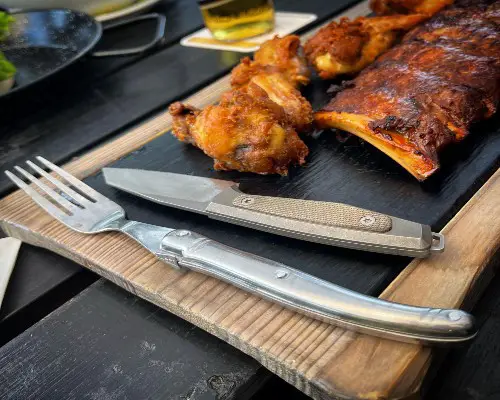
An unexpected fall, a mishap during a weekend game, or a simple accident around the house – just like that, you find yourself nursing a broken arm, staring down at the cast and thinking, “Now what?” It’s a situation none of us anticipate, yet many of us have encountered or will encounter at some point in our lives.
Navigating everyday tasks suddenly becomes a daunting challenge, the monotony of inactivity seeping in. But before you succumb to frustration, take a breath. I know it’s tough, inconvenient, and even painful at times. But as peculiar as it may sound, this obstacle could open a world of new possibilities you never considered.
In the forthcoming exploration, we will unveil a diverse array of activities that you can enjoy, even with your arm in a cast. We’re moving beyond the obvious, beyond the standard responses, delving into a realm of creativity, fun, and, surprisingly, self-improvement.
Understanding the Challenges of a Broken Arm
Having a broken arm can be a challenging experience, affecting both physical capabilities and mental well-being. Arm fractures account for roughly half of all fractured bones in adults. It’s important to understand these challenges to effectively manage them and maintain a positive outlook during the healing process.
Physical Limitations and How to Overcome Them
1. The Challenge of Limited Mobility
A broken arm significantly limits mobility and the ability to perform daily tasks. Simple activities like eating, dressing, or typing can become daunting.
Tip: Use assistive devices like a reacher grabber to pick up objects without straining your arm.
2. The Pain Factor
Pain is a common issue with a broken arm. It can be constant or occur when trying to move the arm.
Note: Always consult with your healthcare provider for appropriate pain management strategies.
3. Overcoming Physical Limitations
Despite these challenges, there are ways to adapt and overcome physical limitations:
- Adapt your environment: Rearrange your living space to make it more accessible. Keep frequently used items within easy reach.
- Use assistive devices: Tools like button hooks, zipper pulls, and one-handed can openers can make daily tasks easier.
- Seek professional help: Occupational therapists can provide strategies and exercises to improve independence and functionality.
Psychological Impact of a Broken Arm
1. The Emotional Toll
A broken arm can also take an emotional toll. Feelings of frustration, sadness, or anxiety are common, especially if the recovery process is slow or if the injury impacts your ability to work or participate in favorite activities.
2. Coping with the Psychological Impact
Here are some strategies to cope with the psychological impact of a broken arm:
- Stay connected: Keep in touch with friends and family. Social support can help alleviate feelings of isolation.
- Engage in enjoyable activities: Find activities you can do with a broken arm, like reading, listening to music, or watching movies.
- Practice mindfulness and relaxation techniques: Techniques like deep breathing, meditation, and progressive muscle relaxation can help manage stress and anxiety.
Remember, it’s normal to have emotional ups and downs after an injury.
8 Fruitful And Beneficial Things to Do with a Broken Arm
Fun and Engaging Activities for Kids with a Broken Arm
Dealing with a broken arm can be a tough time for kids. It puts a damper on their playtime, making them feel left out of their usual activities. Forearm fractures are second only to shattered collarbones in children. But fear not! There are still numerous engaging activities they can enjoy even with one arm. Let’s take a look at some of these inventive and entertaining options.
1. Creative Arts and Crafts Projects

Art has always been a cathartic process, and it’s a great way to keep kids occupied. It’s a field teeming with possibilities, even for the one-handed. Here are a few one-hand-friendly projects:
a. One-handed painting: This can be as simple as abstract finger painting or more advanced like watercolor brushwork.
b. Origami: Though it seems two-handed, many simple origami creations can be made one-handed with a little practice.
c. Pottery: Clay is very forgiving and can be molded one-handed, allowing for unique pieces.
Note: Ensure all craft supplies are non-toxic and age-appropriate. You might also need to lend a hand with preparation or clean-up.
2. One-Handed Board Games and Puzzles
Board games and puzzles aren’t just fun — they’re also excellent for stimulating the mind. Thankfully, many games can be played with just one hand:
a. Card games: From UNO to Go Fish, card games are perfect for one-handed play.
b. Board games: Games like Checkers, Battleship, or Scrabble can easily be played one-handed.
c. Puzzles: While a 1000-piece puzzle might be challenging, smaller puzzles can be fun and satisfying to complete.
According to a study by Cognitive Psychology, puzzles, and board games can improve memory and cognitive functions.
3. Exploring the World of Audiobooks and Podcasts

Though it may seem a bit different from the usual play, audiobooks, and podcasts can be an entertaining and educational experience for kids. They can learn about other cultures, listen to exciting stories, or even follow kid-friendly science shows, all without needing to turn a page or click a mouse.
a. Audiobooks: From Harry Potter to The Hobbit, there’s a vast range of children’s literature available in audio format.
b. Podcasts: Shows like “Wow in the World” and “But Why: A Podcast for Curious Kids” are great examples of child-friendly podcasts.
A 2019 report from Booknet Canada suggested that audiobook listeners are more likely to be avid readers, fostering a love for stories and learning.
4. Light Physical games and activities
Even with a broken arm, kids can still engage in light physical activities that will keep them active and entertained. It’s essential to ensure that these activities don’t strain the injured arm, while still providing a fair amount of excitement. Here are a few suggestions:
a. Upper body exercises: With guidance from a physical therapist or doctor, kids can engage in upper body exercises like push-ups, pull-ups, and chin-ups using their uninjured arm. This can help maintain strength in the rest of the body while the broken arm heals.
b. One-armed bean bag toss: This game can be played with one hand and is a fun way to improve hand-eye coordination.
c. Kicking games: Modify traditional games like soccer or kickball to allow your child to participate without using their broken arm.
d. Dance party: Kids can let loose and groove with their uninjured arm, a fantastic way for them to have fun and burn off energy.
e. Scavenger hunt: Organize a scavenger hunt where kids can search for items using their one good arm. It’s a fun adventure that’s both mentally and physically engaging.
f. Visit a zoo or aquarium: These outings require little physical exertion and are a delightful way for kids with broken arms to learn and stay engaged.
Always remember, that safety comes first. Ensure any physical activity your child participates in won’t risk further injury to their arm. As long as precautions are taken, these activities can help fill their time with joy and engagement, even with a broken arm.
These fun and engaging activities prove that a broken arm doesn’t mean an end to fun times. With a bit of creativity and adaptation, there’s still a world of discovery and enjoyment at their fingertips.
Practical Activities for Adults with a Broken Arm
A broken arm can be a significant disruption to an adult’s daily routine. From work to meals to exercise, it seems everything becomes twice as challenging. However, with a little adaptation and some ingenuity, it’s possible to carry on with most of your activities. Let’s delve into some practical activities and strategies that can help you stay productive and active during the healing period.
1. Mastering One-Handed Typing and Computer Use
In this digital age, we heavily rely on computers for work, social connections, and entertainment. Having a broken arm doesn’t mean these activities need to come to a halt. It’s all about mastering the art of one-handed typing and computer use:
a. Keyboard shortcuts: Learn the keyboard shortcuts for copy, paste, and other common commands to reduce the need for two hands.
b. Voice-to-text software: Use speech recognition software like Google Docs Voice Typing or Dragon Naturally Speaking to navigate and type with ease.
c. One-handed keyboard layout: Some operating systems offer a one-handed keyboard layout that could help increase typing speed and efficiency.

A survey by Brandwatch revealed that an average office worker spends around 1,700 hours per year in front of a computer screen. Therefore, getting comfortable with one-handed typing and navigation can significantly help maintain productivity.
2. Cooking and Meal Prep with One Hand

Cooking with one hand may sound daunting, but with some handy techniques and kitchen tools, it’s entirely achievable:
a. Use a food processor: This can handle chopping, grating, and mixing tasks that would usually require two hands.
b. Stabilizing bowls and cutting boards: Use non-slip mats or damp cloths underneath bowls and boards to keep them steady.
c. Easy-open cans and jars: Look for pull-tab cans, and consider a one-handed jar opener to make the process easier.
Remember, safety is paramount. Avoid dealing with hot oils or boiling water single-handedly. Opt for simpler meals during this time, or consider meal delivery services for hassle-free dining.
3. Staying Fit: One-Armed Workouts
Maintaining physical fitness is essential, even when you’re nursing a broken arm. Here are some exercises you can do:
a. Cardio: Consider stationary bikes or lower-body exercises like squats or lunges that don’t put stress on your arm.
b. Strength training: For the uninjured arm and other parts of the body, consider dumbbell exercises, resistance bands, or leg presses.
c. Yoga: Many yoga poses focus on balance and core strength and can be adapted for one-arm use.

A study by the American College of Sports Medicine revealed that resistance training could improve mental health, reduce the risk of chronic diseases, and enhance life quality. Therefore, keeping active can aid not only physical but also mental recovery.
4. Relax and Learn: Leisure and Self-Improvement Activities
Apart from the practical activities, it’s essential to keep the mind active and spirits high during recovery. You can indulge in a variety of leisure activities, all manageable with one hand. In addition, this might be a perfect opportunity to learn something new or pick up a hobby. Let’s explore these ideas further:
a. Reading: Immersing yourself in a gripping novel or an enlightening non-fiction book is a fantastic way to pass the time. E-readers and tablets are particularly handy as they can be operated with one hand, and the text size can be adjusted for comfortable reading.
b. Watching TV or movies: Whether it’s catching up on your favorite TV shows, discovering a new series, or watching a movie, this activity is relaxing and doesn’t require much physical effort.
c. Online courses: If you’ve ever wanted to learn a new language, delve into history, or understand the cosmos, now could be the perfect time. Websites like Coursera, Udemy, and Khan Academy offer a wide range of online courses that can be followed at your own pace.
d. Coloring or painting: Art can be therapeutic. Depending on which arm is broken, you can try coloring or painting. Adult coloring books have gained popularity for their stress-relieving properties, and painting can be a joyful way to express creativity.
e. Writing: Journaling your experience or writing in general can be a therapeutic way to cope with the challenges of a broken arm. It’s also an excellent opportunity to try one-handed typing!
f. Board games: Socializing is an important part of recovery, and board games are a perfect excuse to invite friends or family over. Many games can easily be played with one hand, making for a fun and interactive pastime.
In a survey by the Pew Research Center, 73% of adults consider themselves lifelong learners and 74% have engaged in at least one act of personal learning in the past year. Therefore, incorporating learning activities during recovery could make the period more productive and enjoyable. Remember, your well-being is key, so ensure you strike a balance between rest and activity.
Tips for Making Everyday Tasks Easier with a Broken Arm
Coping with a broken arm can seem like a daunting task, with every mundane chore feeling like a Herculean effort. But don’t worry! With a few adaptations and some patience, you can still maintain your independence and comfort. Here are some valuable tips:
1. Dressing and Personal Care
Personal care with a broken arm requires some patience and a bit of creativity. Here are some tips to make dressing and personal care tasks easier:
a. Loose Clothing: Choose clothes with wide sleeves and loose fits, which are easier to get in and out of. Front-opening shirts or dresses can be simpler to handle.
b. One-Handed Techniques: Learn one-handed techniques for buttoning clothes, tying shoelaces, and zipping up bags.
c. Assistive Tools: Devices like button hooks, long-handled shoe horns, and one-handed nail clippers can make a world of difference.
Remember, it’s okay to ask for help if you need it. It’s better to ensure your safety and comfort rather than risking further injury.
2. Navigating the Kitchen
The kitchen can be a challenging space with a broken arm. Here’s how to make it easier:
a. Prepared Foods: Ready-made meals, or preparing and freezing meals in advance can make mealtime much easier.
b. Kitchen Gadgets: Use a one-handed can opener, a stabilizing cutting board, or an electric peeler. These can make cooking safer and more efficient.

c. One-Pot Recipes: Simplify cooking by sticking to recipes that can be made in one pot or pan to minimize the need for complex handling of kitchen equipment.
Remember, your safety comes first. If a task seems risky, it’s better to wait for help or choose an alternative approach.
3. Driving and Transportation Tips
Depending on the severity of the injury and your comfort level, driving may not be advisable. Always consult with your healthcare provider before you get behind the wheel. Meanwhile, consider alternatives like:
a. Ride-sharing: Services like Uber or Lyft can be convenient for getting around without the need to drive.
b. Friends and Family: Don’t hesitate to ask for help when you need it. People who care about you will be willing to assist.
Embracing the Healing Process
Getting through the recovery period can be just as much about mental resilience as it is about physical healing. Here’s how you can embrace the healing process:
1. The Importance of Rest and Rehabilitation
Make sure to follow your doctor’s advice, get plenty of rest, and engage in recommended rehabilitation exercises to promote healing and regain strength and flexibility in your arm.
2. Staying Positive During Recovery
Keep your spirits high by staying socially connected, engaging in enjoyable activities, and practicing mindfulness. Remember, positivity plays a key role in the healing journey.
FAQs
Q1: What should I do immediately after breaking my arm?
A: After breaking your arm, it is essential to seek medical attention right away. Do not attempt to reset the bone yourself or ignore the injury.
Q2: How should I handle a broken arm before medical help arrives?
A: To stabilize the arm until medical attention arrives, you can gently support it with a makeshift splint or sling. Use a scarf, belt, or any long cloth to tie the arm against the body. Remember to avoid putting pressure directly on the site of the fracture.
Q3: Can I drive with a broken arm?
A: It is generally not recommended to drive with a broken arm, especially if it’s your dominant arm. Pain, restricted range of motion, and the need to focus on the road may hamper your ability to drive safely. Seek alternative transportation or ask someone for assistance.
Q4: How can I manage personal care with a broken arm?
A: Taking care of yourself with a broken arm requires patience and some adaptations. Opt for loose-fitting, front-opening clothes, practice buttoning and tying clothes with one-hand shoelaces, and consider using assistive tools like button hooks and one-handed nail clippers. Asking for help when needed is also important to ensure your safety and comfort.
Q5: How can I stay positive during the recovery process?
A: Staying positive during recovery involves focusing on mental health alongside physical health. Maintain social connections, engage in enjoyable activities, and practice mindfulness or meditation. According to a study by Mayo Clinic, positive thinking can result in better psychological and physical well-being.
Q6: How long does it take for a broken arm to heal?
A: Simple fractures can take around five to eight weeks to heal, while more complex fractures may require several months. The healing time for a broken arm varies depending on several factors, such as the location and severity of the fracture. Your doctor will provide a more accurate estimate based on your specific situation.
Q7: How can I prevent future arm injuries?
A: To help prevent future arm injuries, it’s important to maintain good bone health. This includes consuming a balanced diet rich in calcium and vitamin D, engaging in weight-bearing exercises, using proper protective gear during physical activities, and taking precautions to avoid falls or accidents.
Conclusion
In conclusion, having a broken arm might feel like an impediment, but it does not have to confine your activities entirely. We’ve explored a multitude of engaging, fun, and productive activities, from mastering one-handed typing to partaking in adaptive workouts, keeping in mind both the physical and mental aspects of recovery.
Remember, your recovery journey is a unique blend of healing, adaptability, and resilience. Embrace the challenge as an opportunity to learn new skills and to appreciate the dexterity and resilience you possess. Above all, staying positive and patient, while taking care of your overall well-being, is paramount in navigating life with a broken arm.

